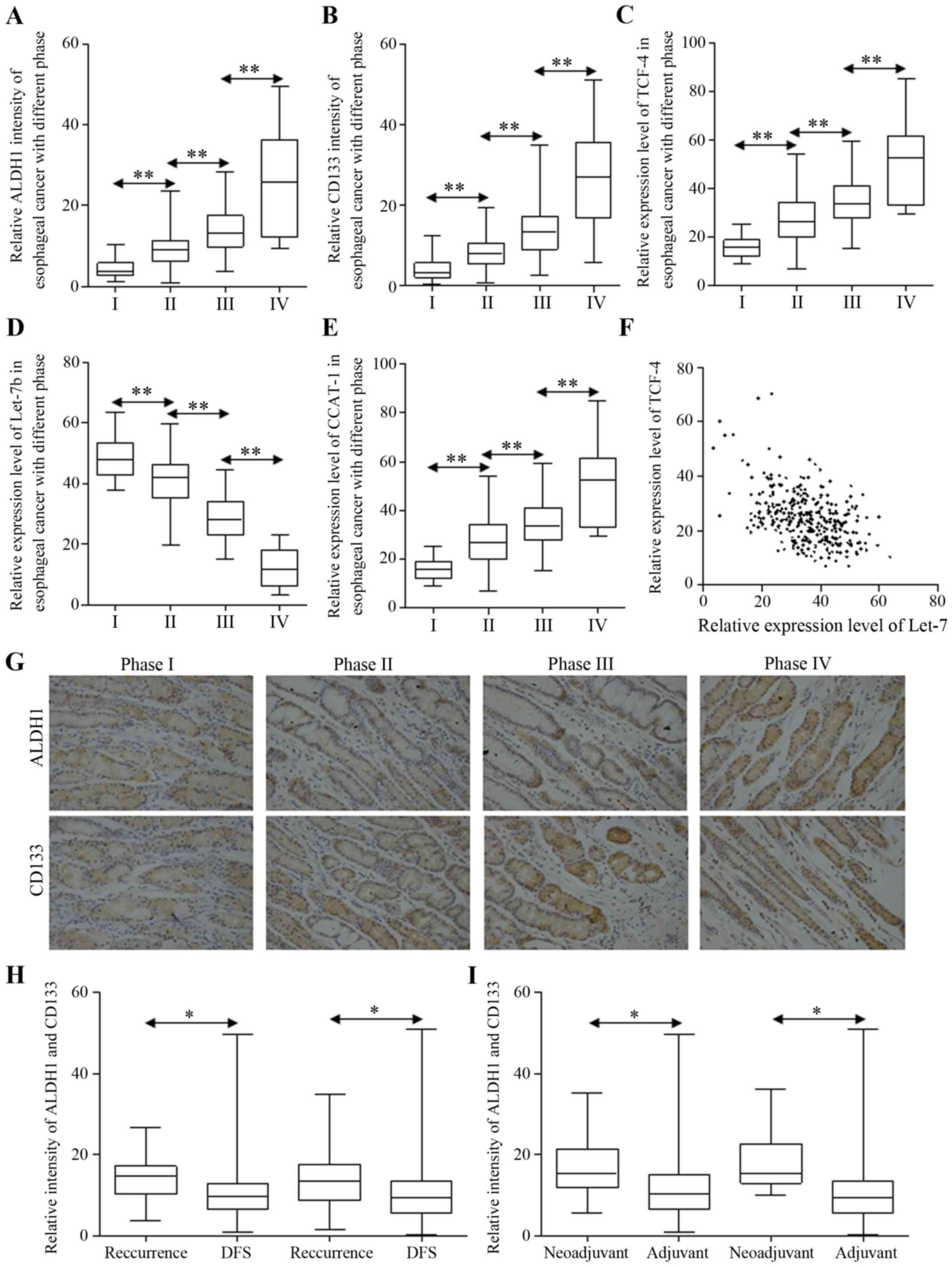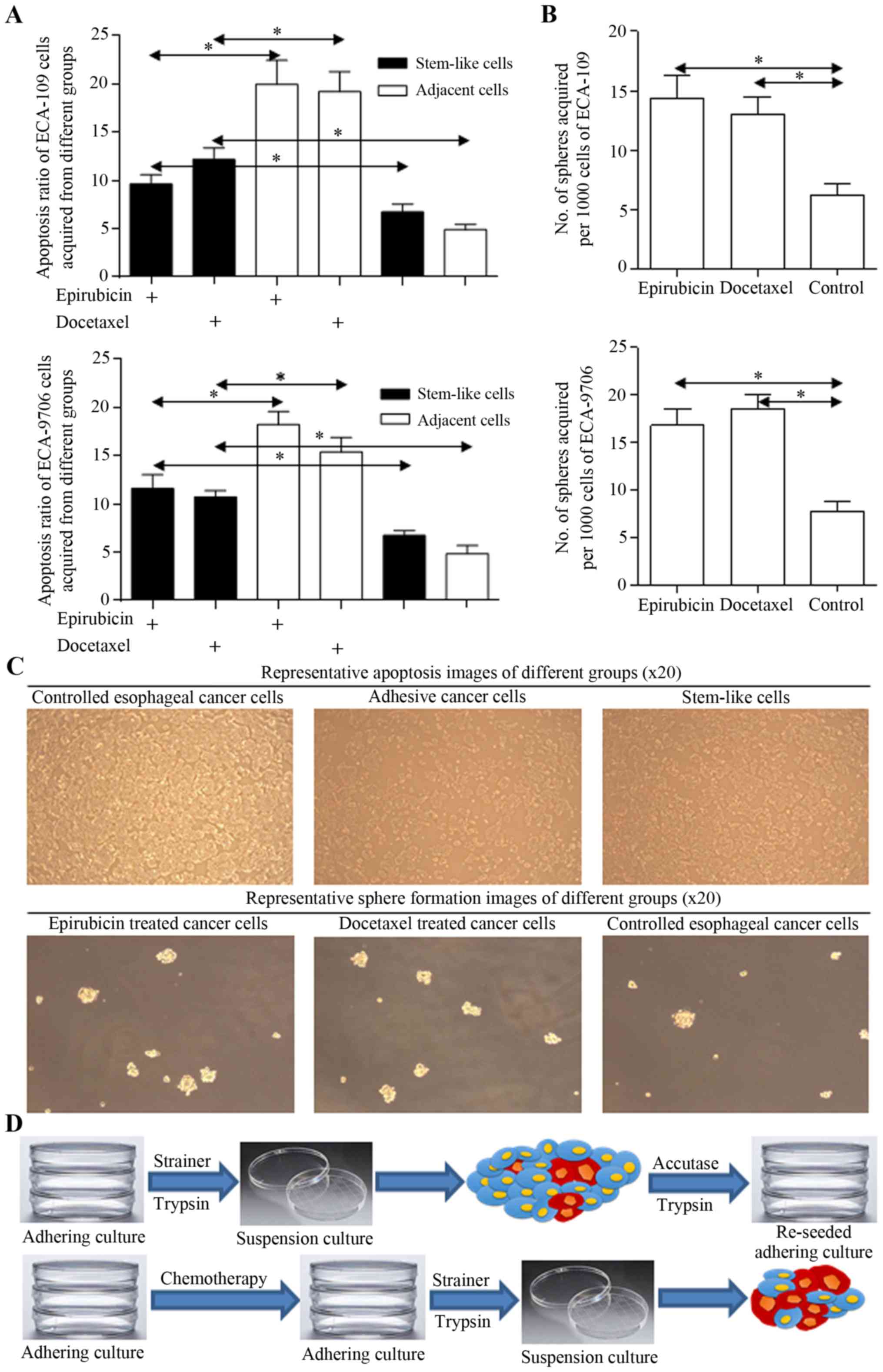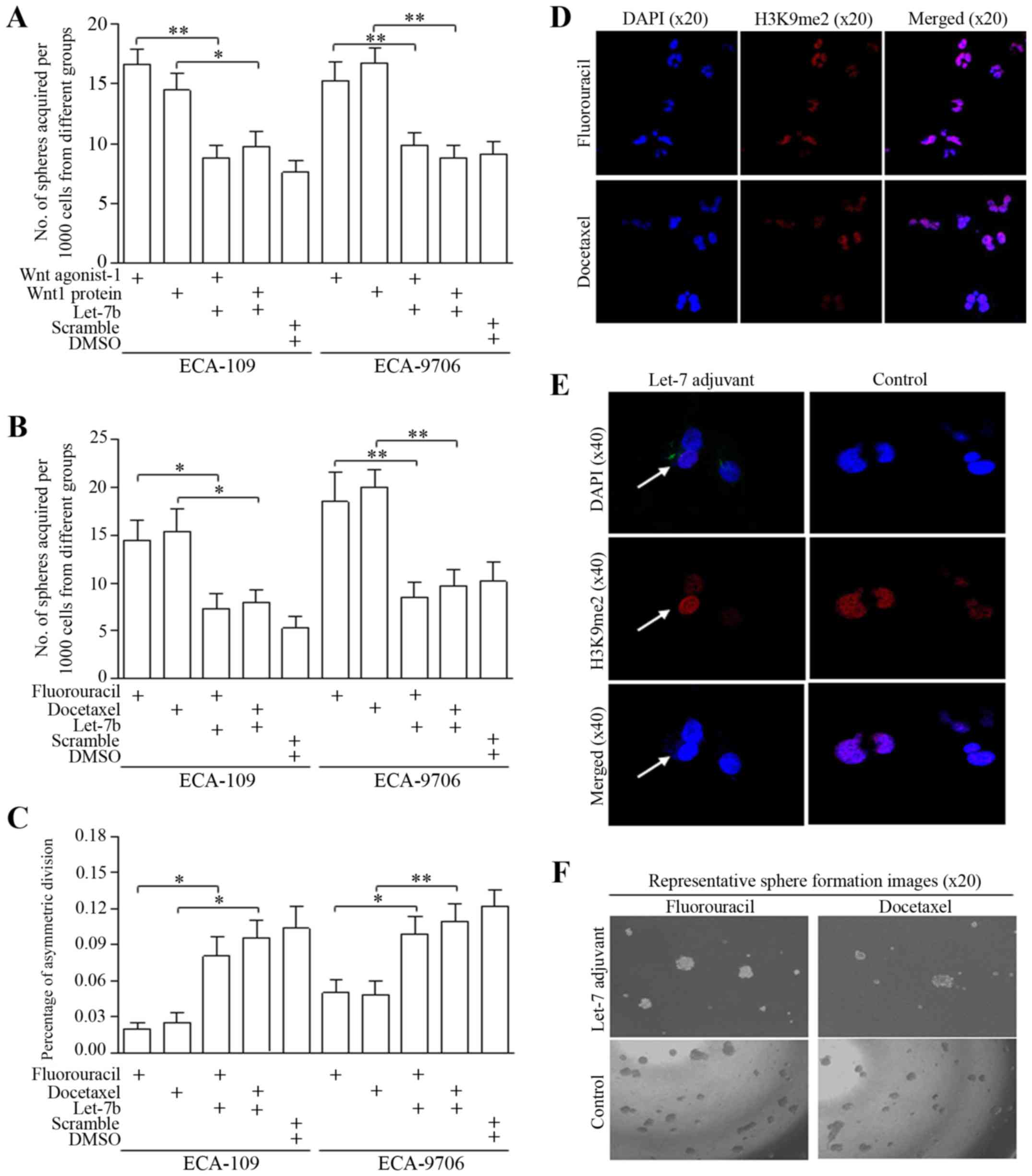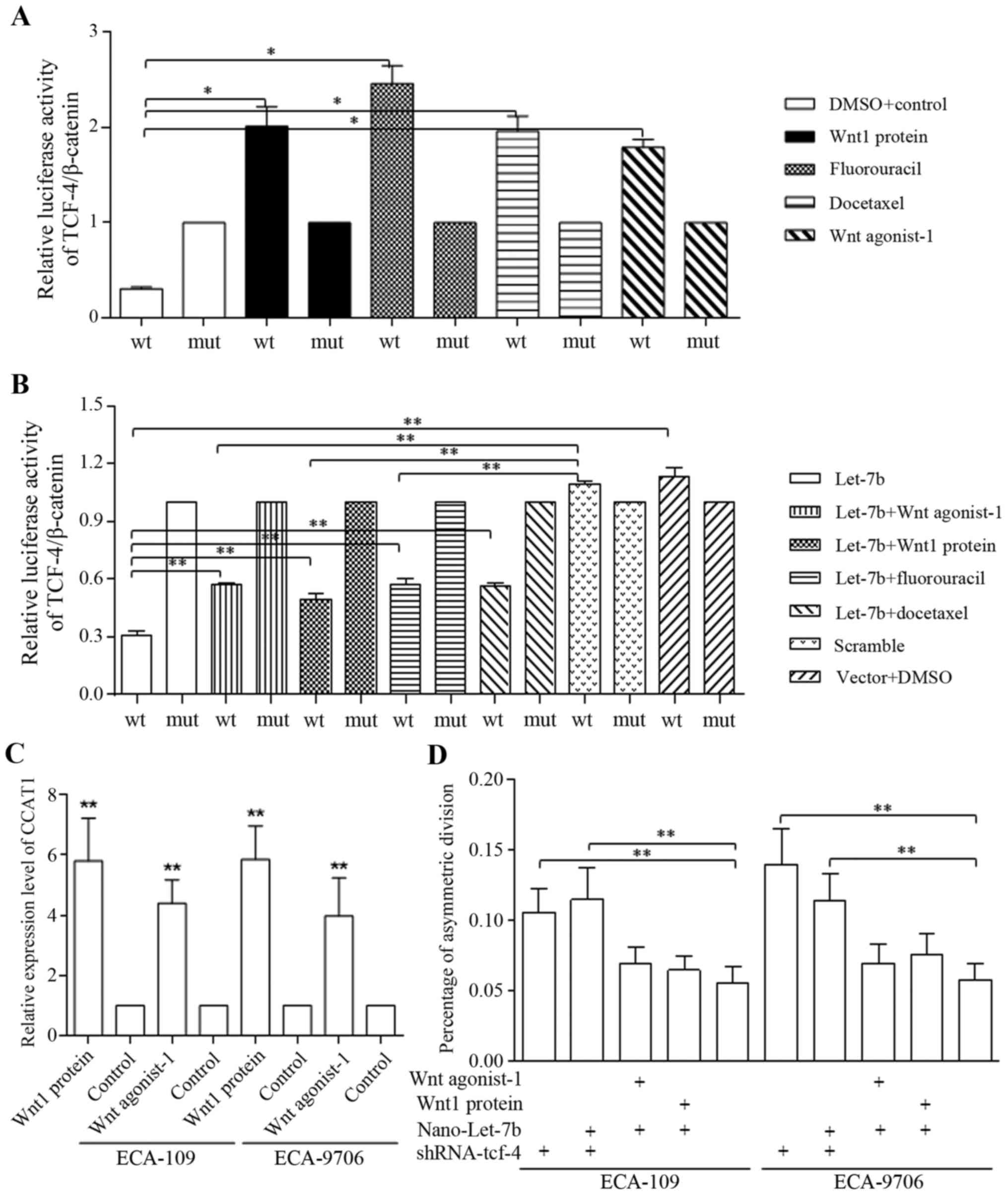|
1
|
Rustgi AK and El-Serag HB: Esophageal
carcinoma. N Engl J Med. 371:2499–2509. 2014. View Article : Google Scholar : PubMed/NCBI
|
|
2
|
Pennathur A, Gibson MK, Jobe BA and
Luketich JD: Oesophageal carcinoma. Lancet. 381:400–412. 2013.
View Article : Google Scholar : PubMed/NCBI
|
|
3
|
Song Y, Li L, Ou Y, Gao Z, Li E, Li X,
Zhang W, Wang J, Xu L, Zhou Y, et al: Identification of genomic
alterations in oesophageal squamous cell cancer. Nature. 509:91–95.
2014. View Article : Google Scholar : PubMed/NCBI
|
|
4
|
Sun X, Liu J, Xu C, Tang SC and Ren H: The
insights of Let-7 miRNAs in oncogenesis and stem cell potency. J
Cell Mol Med. 20:1779–1788. 2016. View Article : Google Scholar : PubMed/NCBI
|
|
5
|
Sun X, Jiao X, Pestell TG, Fan C, Qin S,
Mirabelli E, Ren H and Pestell RG: MicroRNAs and cancer stem cells:
The sword and the shield. Oncogene. 33:4967–4977. 2014. View Article : Google Scholar
|
|
6
|
Wan L, Zhang L, Fan K, Cheng ZX, Sun QC
and Wang JJ: Circular RNA-ITCH suppresses lung cancer proliferation
via inhibiting the Wnt/β-catenin pathway. BioMed Res Int.
2016:15794902016. View Article : Google Scholar
|
|
7
|
Blagodatski A, Poteryaev D and Katanaev
VL: Targeting the Wnt pathways for therapies. Mol Cell Ther.
2:282014. View Article : Google Scholar : PubMed/NCBI
|
|
8
|
Dhar SK, Tangpong J, Chaiswing L, Oberley
TD and St Clair DK: Manganese superoxide dismutase is a
p53-regulated gene that switches cancers between early and advanced
stages. Cancer Res. 71:6684–6695. 2011. View Article : Google Scholar : PubMed/NCBI
|
|
9
|
Hirsch HA, Iliopoulos D and Struhl K:
Metformin inhibits the inflammatory response associated with
cellular transformation and cancer stem cell growth. Proc Natl Acad
Sci USA. 110:972–977. 2013. View Article : Google Scholar : PubMed/NCBI
|
|
10
|
Zhou D, Shao L and Spitz DR: Reactive
oxygen species in normal and tumor stem cells. Adv Cancer Res.
122:1–67. 2014. View Article : Google Scholar : PubMed/NCBI
|
|
11
|
Printz C: Radiation treatment generates
therapy-resistant cancer stem cells from less aggressive breast
cancer cells. Cancer. 118:3225. 2012.PubMed/NCBI
|
|
12
|
Deng L, Yang S-B, Xu F-F and Zhang J-H:
Long noncoding RNA CCAT1 promotes hepatocellular carcinoma
progression by functioning as let-7 sponge. J Exp Clin Cancer Res.
34:182015. View Article : Google Scholar : PubMed/NCBI
|
|
13
|
Sun X, Xu C, Tang SC, Wang J, Wang H, Wang
P, Du N, Qin S, Li G, Xu S, et al: Let-7c blocks estrogen-activated
Wnt signaling in induction of self-renewal of breast cancer stem
cells. Cancer Gene Ther. 23:83–89. 2016. View Article : Google Scholar : PubMed/NCBI
|
|
14
|
Beck B and Blanpain C: Unravelling cancer
stem cell potential. Nat Rev Cancer. 13:727–738. 2013. View Article : Google Scholar : PubMed/NCBI
|
|
15
|
Taylor MD, Poppleton H, Fuller C, Su X,
Liu Y, Jensen P, Magdaleno S, Dalton J, Calabrese C, Board J, et
al: Radial glia cells are candidate stem cells of ependymoma.
Cancer Cell. 8:323–335. 2005. View Article : Google Scholar : PubMed/NCBI
|
|
16
|
Atkinson RL, Yang WT, Rosen DG, Landis MD,
Wong H, Lewis MT, Creighton CJ, Sexton KR, Hilsenbeck SG, Sahin AA,
et al: Cancer stem cell markers are enriched in normal tissue
adjacent to triple negative breast cancer and inversely correlated
with DNA repair deficiency. Breast Cancer Res. 15:R772013.
View Article : Google Scholar : PubMed/NCBI
|
|
17
|
Hang D, Dong HC, Ning T, Dong B, Hou DL
and Xu WG: Prognostic value of the stem cell markers CD133 and
ABCG2 expression in esophageal squamous cell carcinoma. Dis
Esophagus. 25:638–644. 2012. View Article : Google Scholar : PubMed/NCBI
|
|
18
|
Zhu Y, Luo M, Brooks M, Clouthier SG and
Wicha MS: Biological and clinical significance of cancer stem cell
plasticity. Clin Transl Med. 3:322014. View Article : Google Scholar : PubMed/NCBI
|
|
19
|
Zhang Y, Molavi O, Su M and Lai R: The
clinical and biological significance of STAT1 in esophageal
squamous cell carcinoma. BMC Cancer. 14:7912014. View Article : Google Scholar : PubMed/NCBI
|
|
20
|
Zhang G, Ma L, Xie YK, Miao XB and Jin C:
Esophageal cancer tumorspheres involve cancer stem-like populations
with elevated aldehyde dehydrogenase enzymatic activity. Mol Med
Rep. 6:519–524. 2012. View Article : Google Scholar : PubMed/NCBI
|
|
21
|
Yang L, Ren Y, Yu X, Qian F, Bian BS, Xiao
HL, Wang WG, Xu SL, Yang J, Cui W, et al: ALDH1A1 defines invasive
cancer stem-like cells and predicts poor prognosis in patients with
esophageal squamous cell carcinoma. Mod Pathol. 27:775–783. 2014.
View Article : Google Scholar
|
|
22
|
Rodriguez-Torres M and Allan AL: Aldehyde
dehydrogenase as a marker and functional mediator of metastasis in
solid tumors. Clin Exp Metastasis. 33:97–113. 2016. View Article : Google Scholar :
|
|
23
|
Hwang C-C, Nieh S, Lai C-H, Tsai CS, Chang
LC, Hua CC, Chi WY, Chien HP, Wang CW, Chan SC, et al: A
retrospective review of the prognostic value of ALDH-1, Bmi-1 and
Nanog stem cell markers in esophageal squamous cell carcinoma. PLoS
One. 9:e1056762014. View Article : Google Scholar : PubMed/NCBI
|
|
24
|
Dey-Guha I, Wolfer A, Yeh AC, G Albeck J,
Darp R, Leon E, Wulfkuhle J, Petricoin EF III, Wittner BS and
Ramaswamy S: Asymmetric cancer cell division regulated by AKT. Proc
Natl Acad Sci USA. 108:12845–12850. 2011. View Article : Google Scholar : PubMed/NCBI
|
|
25
|
Cicalese A, Bonizzi G, Pasi CE, Faretta M,
Ronzoni S, Giulini B, Brisken C, Minucci S, Di Fiore PP and Pelicci
PG: The tumor suppressor p53 regulates polarity of self-renewing
divisions in mammary stem cells. Cell. 138:1083–1095. 2009.
View Article : Google Scholar : PubMed/NCBI
|
|
26
|
Gómez-López S, Lerner RG and Petritsch C:
Asymmetric cell division of stem and progenitor cells during
homeostasis and cancer. Cell Mol Life Sci. 71:575–597. 2014.
View Article : Google Scholar :
|
|
27
|
Fürthauer M and González-Gaitán M:
Endocytosis, asymmetric cell division, stem cells and cancer: Unus
pro omnibus, omnes pro uno. Mol Oncol. 3:339–353. 2009. View Article : Google Scholar : PubMed/NCBI
|
|
28
|
El-Hashash AHK and Warburton D: Numb
expression and asymmetric versus symmetric cell division in distal
embryonic lung epithelium. J Histochem Cytochem. 60:675–682. 2012.
View Article : Google Scholar : PubMed/NCBI
|
|
29
|
Kechad A, Jolicoeur C, Tufford A, Mattar
P, Chow RWY, Harris WA and Cayouette M: Numb is required for the
production of terminal asymmetric cell divisions in the developing
mouse retina. J Neurosci. 32:17197–17210. 2012. View Article : Google Scholar : PubMed/NCBI
|
|
30
|
Martin-Blanco NM, Checquolo S, Del Gaudio
F, Palermo R, Franciosa G, Di Marcotullio L, Gulino A, Canelles M
and Screpanti I: Numb-dependent integration of pre-TCR and p53
function in T-cell precursor development. Cell Death Dis.
5:e14722014. View Article : Google Scholar : PubMed/NCBI
|
|
31
|
Brand AH: A new dawn for Aurora? Nat Cell
Biol. 10:1253–1254. 2008. View Article : Google Scholar : PubMed/NCBI
|
|
32
|
Landen CN Jr, Chavez-Reyes A, Bucana C,
Schmandt R, Deavers MT, Lopez-Berestein G and Sood AK: Therapeutic
EphA2 gene targeting in vivo using neutral liposomal small
interfering RNA delivery. Cancer Res. 65:6910–6918. 2005.
View Article : Google Scholar : PubMed/NCBI
|
|
33
|
Seviour EG, Sehgal V, Mishra D, Rupaimoole
R, Rodriguez-Aguayo C, Lopez-Berestein G, Lee J-S, Sood AK, Kim MP,
Mills GB, et al: Targeting KRas-dependent tumour growth,
circulating tumour cells and metastasis in vivo by clinically
significant miR-193a-3p. Oncogene. 36:1339–1350. 2017. View Article : Google Scholar
|
|
34
|
Rupaimoole R, Ivan C, Yang D, Gharpure KM,
Wu SY, Pecot CV, Previs RA, Nagaraja AS, Armaiz-Pena GN, McGuire M,
et al: Hypoxia-upregulated microRNA-630 targets Dicer, leading to
increased tumor progression. Oncogene. 35:4312–4320. 2016.
View Article : Google Scholar : PubMed/NCBI
|
|
35
|
Sun X, Jiang S, Liu J, Wang H, Zhang Y,
Tang SC, Wang J, Du N, Xu C, Wang C, et al: MiR-208a stimulates the
cocktail of SOX2 and β-catenin to inhibit the let-7 induction of
self-renewal repression of breast cancer stem cells and formed
miR208a/let-7 feedback loop via LIN28 and DICER1. Oncotarget.
6:32944–32954. 2015. View Article : Google Scholar : PubMed/NCBI
|
|
36
|
Hwang W-L, Jiang J-K, Yang S-H, Huang TS,
Lan HY, Teng HW, Yang CY, Tsai YP, Lin CH, Wang HW, et al:
MicroRNA-146a directs the symmetric division of Snail-dominant
colorectal cancer stem cells. Nat Cell Biol. 16:268–280. 2014.
View Article : Google Scholar : PubMed/NCBI
|
|
37
|
Lathia JD, Hitomi M, Gallagher J, Gadani
SP, Adkins J, Vasanji A, Liu L, Eyler CE, Heddleston JM, Wu Q, et
al: Distribution of CD133 reveals glioma stem cells self-renew
through symmetric and asymmetric cell divisions. Cell Death Dis.
2:e2002011. View Article : Google Scholar : PubMed/NCBI
|
|
38
|
Todaro M, Francipane MG, Medema JP and
Stassi G: Colon cancer stem cells: Promise of targeted therapy.
Gastroenterology. 138:2151–2162. 2010. View Article : Google Scholar : PubMed/NCBI
|
|
39
|
Morrison SJ and Kimble J: Asymmetric and
symmetric stem-cell divisions in development and cancer. Nature.
441:1068–1074. 2006. View Article : Google Scholar : PubMed/NCBI
|
|
40
|
Berika M, Elgayyar ME and El-Hashash AHK:
Asymmetric cell division of stem cells in the lung and other
systems. Front Cell Dev Biol. 2:332014. View Article : Google Scholar : PubMed/NCBI
|















